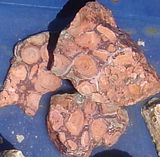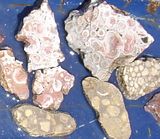raqy
Senior Member
  
Posts: 89
|
Post by raqy on Jul 19, 2008 17:57:07 GMT -5
Hi all, I went to NM for a lil vacation, I found this and I have no idea as to what it could be.. please help... here are some clickable thumbnails:     Thanks in advance!! |
|
|
|
Post by arappaho on Jul 19, 2008 20:53:31 GMT -5
Cool Stuff, raqy! Love that red/magenta color. I'll venture a guess that it's some Spherulitic Rhyolite. I'm finding some around here,too. But your spheres are huge compared to mine or any other types that I've seen. You better go back and get some more just to be safe.  Joe |
|
raqy
Senior Member
  
Posts: 89
|
Post by raqy on Jul 20, 2008 11:14:27 GMT -5
Thanks Joe!
After googling Spherulitic Rhyolite the pics look pretty similar.. only difference was the color. I'm gonna have to get my son to send me some more. Of the red there was very little but the other there was tons. Can't wait to go back home for another visit.
|
|
|
|
Post by lauriesrocks on Jul 20, 2008 21:05:51 GMT -5
Those look like stromatolites, which are fossilized microbial mats. Were they found in a carbonate rock environment, such as limestone or gypsum?
|
|
raqy
Senior Member
  
Posts: 89
|
Post by raqy on Jul 20, 2008 21:58:37 GMT -5
Actually yes the deeper colored one was, there was quite a bit of gypsum as for the lighter one no but the entire cliff seemed to be of this...
Thanks!
|
|
|
|
Post by arappaho on Jul 21, 2008 21:01:25 GMT -5
Yes, raqy, I'm glad Laurie got in on this. I wanted to tell you that Spherulitic Rhyolite was just ONE possibility for your rock.  I would guess you have two choices as far as an ID. Rhyolite can be formed in several different ways but basically it is a volcanic MAGMA type rock. The spherules grow until cool. There would probably be some 'flow' evident somewhere in the deposit you collected this from. And I was wondering about the bottom portion of the large magenta rock. Is that a 'flow'? Also, some part of the rocks look like a breccia, which could also be associated with volcanic activity. On the other hand, what Laurie is suggesting is of organic origin, which would involve a sedimentary formation. Figuring out if your deposit is volcanic or sedimentary would, possibly ;D, give you an identification. I'm thinking Laurie might be more on the right track here so let us know what you find out. I just think spherules in rock are way cool, but I'm afraid I'm not up on all the organic or sedimentary possibilities. Good Luck, Joe |
|
raqy
Senior Member
  
Posts: 89
|
Post by raqy on Jul 22, 2008 20:27:34 GMT -5
Ok Joe I think this is way over my head.. think its pretty tho ha.
|
|
|
|
Post by dixieeuhedrals on Jul 22, 2008 20:53:47 GMT -5
you can take a glass of vinegar ( acetic acid ) and drop a piece into the vinegar . If it reacts and bubbles , this would indicate limestone and not rhyolite . If the rock is porous , it may bubble a little , not because of reacting with the acid but rather the liquid filling the pores of the rock and displacing air - this would be different than in the case of limestone reacting to acid .
|
|
|
|
Post by arappaho on Jul 22, 2008 20:57:32 GMT -5
Now, raqy, if I can try to figure this stuff out
it's got to be simple. ;D
Joe
|
|
raqy
Senior Member
  
Posts: 89
|
Post by raqy on Jul 24, 2008 21:19:18 GMT -5
Ok I'm gonna try the vinegar test and let you know what it does.. Joe, it did not sound simple at all, at least not for me.. I'm a newb, ya know.
|
|